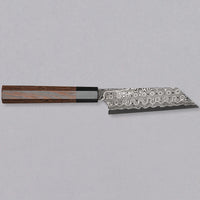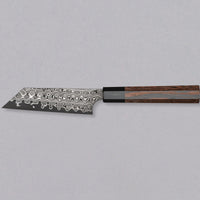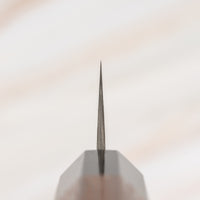


Nigara Kiritsuke Petty SG2 Damascus 120mm (4.7")
|
✔︎ No import fees & duties - worldwide |
- Description
- Specifications
- Knife Care
- Shipping
Nigara Kiritsuke Petty SG2 Damascus 120mm (4.7") is a small Japanese kitchen knife, intended for all those smaller tasks where larger and wider knives are deemed unwieldy. Aside from excelling at usual tasks, such as peeling, paring and other in-hand cutting, you can use it for some heavier work as well. Light butchering, poultry deboning, and fish filleting are completely within its reach (🚨 Just keep in mind that it's still an extremely hard knife, so cutting through bones and joints is out of the question!). The pronounced “K-tip” proves very useful with fine, decorative work with vegetables and fruit, as well as with trimming and skinning, as it’s great for piercing through the skin.
It’s hard not to notice the eye-catching and masterfully made damascus finish on the blade, which is dotted with circular elements, also known as a raindrop damascus pattern. This kind of damascus finish, also called the “Anmon” technique, is now almost a trademark for Nigara Hamono and draws its inspiration from the majestic Anmon Waterfalls and the breathtaking sight of rippling water beneath them.
Another feature that catches the eye is the reverse-tanto tip, also known as a “K-tip” (K for kiritsuke) that slopes downward from the spine and has some great practicality, as it enables precise and effortless work with the tip. The belly of the blade is slightly curved and the overall blade size is much smaller, which differentiates it from a standard, flatter kiritsuke shape and makes it a sort of kiritsuke-petty hybrid. This means that the knife can be utilized well for rocking motions, too.
BLADE SHAPE:
Petty knives are designed for smaller tasks on and off the cutting board. It's an indispensable knife in any kitchen and can be used for peeling, mincing, paring, and decorating food. The blade ends in a "K-tip" tip, typical of Japanese swords and daggers. Petty or utility knives are basically a smaller version of gyutos or chef's knives. Due to the length of the blade, it can also be used as a stand-alone knife if you are uncomfortable with longer blades. A must-have knife in every kitchen!
Use for: peeling, trimming, garnishing, carving, chopping herbs, chopping garlic, slicing small pieces of dried meat, trimming meat, filleting small portions of fish, and similar tasks.
*The length of the cutting edge is 110mm (4.3") (heel to point), but with this knife the length is measured from the edge of the handle to the tip of the blade, amounting to 120mm (4.7").
STEEL:
SG2 steel is a powder steel, renowned for its hardness and subsequent edge retention—due to a high carbon (C) content of 1.5%. The steel is also high in chromium (Cr)—around 15%, which adds to corrosion resistance and Molybdenum (Mo) which improves the blade’s wear resistance. SG2 steel blades will be able to achieve a fine sharpness due to the fine microstructure of the steel and will keep it—without having to worry about maintenance and corrosion.
LAMINATION:
A high hardness of around 64 HRC means the blade won’t be very tough, so the blade’s core was laminated using the san-mai method to improve its structural integrity and subsequent ability to withstand impacts and prevent chipping. San-mai translates to “three layers” in Japanese, referring to a blade that is composed of a primary, inner layer of harder steel (hagane) and of two secondary, outer layers of softer steel (jigane) that protect the prior.
GEOMETRY:
It has a double bevel (symmetrical) blade with convex (full hamaguri) grind. Hamaguri grind allows superior sharpness that requires delicate handling and helps to prevent food from sticking to the blade. Such a shape keeps a lot of metal behind the edge and makes for a stronger edge, yet it still allows a good degree of sharpness. The downside to a convex grind is that it is very hard to reproduce by anyone other than a very experienced sharpener.
The blade has a distal taper - at the tang, the blade is 2.0mm (0.08") thick and narrows towards the tip, where it is 1.6mm (0.06") thick. This gives it more strength and weight at the handle (meaning we can exert more pressure with the heel) and more precision at the tip, allowing for smooth and precise cuts.
BLADE FINISH:
The blade is adorned with a raindrop damascus pattern. This technique, also known as the Anmon design, is the work of the current head blacksmith of Nigara Hamono, Tsuyoshi Yoshizawa. The cutting edge of the knife has a forced patina to match the dark gray appearance of the blade.
HANDLE:
Japanese (Wa) style wenge wood handle with a buffalo horn ferrule. The symmetrical octagonal shape of the handle makes it suitable for both left- and right-handed users.
BLACKSMITH:
Nigara Hamono is a historic smithy with a 350-year tradition. It has been active in the city of Hirosaki since the early Edo Period, when it started making swords for the Tsugaru clan. With over a hundred forging shops in the region during that era, Nigara Forging stands as a testament to Tsugaru Uchihamono's rich history and artistry.
Iron production has a long history in the Tsugaru region near Mount Iwaki. Artifacts made from iron used during the Nara Period (710-794) and early Heian Period (794-1192) have been found around the city of Hirosaki, indicating there was a vast group of ironworks in the region. The presence of Kaji-machi, or the blacksmith town, further signifies the historical significance of the region.
For more than 350 years, Nigara Hamono has been a distinguished family of swordsmiths. Initially appointed by the region of Tsugaru to craft Japanese swords, the smithy transitioned to knife-making after the traditional swordsmithing techniques gained recognition during World War II.
While sword production ceased in 1965, Nigara Hamono continues to preserve traditional forging techniques, showcasing its artistry through Honuchi knives – authentic Japanese knives made with traditional methods, which exemplify the skill and experience accumulated throughout numerous generations of blacksmiths.
With their crafted items being officially certified as Aomori Prefecture Traditional Crafts in December, 2007, Nigara Hamono stands as a living testament to the enduring traditional craftsmanship rooted in the town of Hirosaki, Japan.
The current head blacksmith of Nigara Hamono, Tsuyoshi Yoshizawa, who works alongside his father Toshi Yoshizawa, is an eighth-generation blacksmith with a passion for knives, art and music. His famous Nigara Anmon design is the result of his love of Andy Warhol’s artwork.
Blade shape: Kiritsuke Petty
Steel type: SG2
Blade construction: San-mai / Hamaguri / Damascus
Hardness (HRC scale): 64
Overall length: 240mm (9.4")
Blade length: 110mm (4.3")
Blade height: 31mm (1.2")
Spine thickness: 2.0 (0.08") - 1.6mm (0.06")
Weight: 65g (2.3 oz)
Handle length: 115mm (4.5")
Handle type / wood: Japanese (Wa) style / Wenge
Kanji on the blade:
Blacksmith: Nigara Hamono
Location of the smithy: HIROSAKI / Aomori Prefecture / Japan
☝️ Japanese kitchen knives in our store are handmade from natural materials. Slight variations in color, texture, weight and other dimensions are possible. We try to give a good photographic representation of our products, however computer screen resolution and colors do vary, so products might not look exactly as they are seen on screen.

Blade wear depends on the quality of steel, usage and maintenance of the blade. Japanese knives are made of high-quality steels. Follow these tips to keep your Japanese knife in top-notch shape:
✔ Use a wooden, plastic or rubber cutting board.
✔ After use, wash the knives and wipe them dry.
✔ For storage, use a knife holder or a protective knife sheath (saya).
✔ A good cutting technique is your best bet to prolong sharpness.
✔ Use sharpening stones to sharpen the knife.
❗️Don’t leave the knife in the sink. Wash it by hand.
❗️Don’t wash the knife in the dishwasher.
❗️Don’t use the knife on glass, ceramics, marble or steel surfaces.
❗️Don’t scrape the food off the cutting board with the edge of the blade. Use the spine of the knife instead.
❗️Knife is a tool intended for specific use - cutting food. It is not a can opener, screwdriver, trowel, wire cutter, hammer etc.
→ For more details, read our guide
on Maintenance of Kitchen Knives.
🤙 Contact us if you need some help. We reply within 1 business day.
SHIPPING RATES:
- €10 - flat worldwide rate with DHL Express (express delivery, 2-5 business days).
- FREE - all orders over €300 (DHL Express).
EXCEPTIONS:
See our Shipping page for more details.
DUTIES AND IMPORT TAXES:
We ship all orders DDP (duties & taxes paid). This means you will not be charged for any import fees and taxes (including VAT). All our prices are final. The price you see at checkout is the final price, no hidden costs.
DELIVERY TIME:
- Europe: 1-2 business days
- US & Canada: 2-4 business days
- Rest of the World: 3-5 business days
RETURNS:
Our return policy lasts 30 days. If more than 30 days have gone by since the day you received your order, unfortunately we can’t offer you a refund or exchange.
→ Read our SHIPPING & RETURNS policy for more info. We strive to solve any issues fast and with as little hassle for you. If you have some additional questions, please contact us.
Each knife comes with:
✔️ Instructions and knife care leaflet.
✔️ A preventive Band-Aid – the knives are very sharp! 😉
✔️ Original box from the blacksmith, which we wrap in an old Japanese newspaper sheet – so every knife is ready to be passed on as a gift as soon as it hits your doorstep!
✔️ We also offer a special gift wrapping option with the traditional Japanese washi paper.
QUIZ
Still doubting which type of Japanese knife should best fit your needs?
We created a 5-steps quiz to help you find the perfect knife based on your cooking skills and the type of food you prepare.



